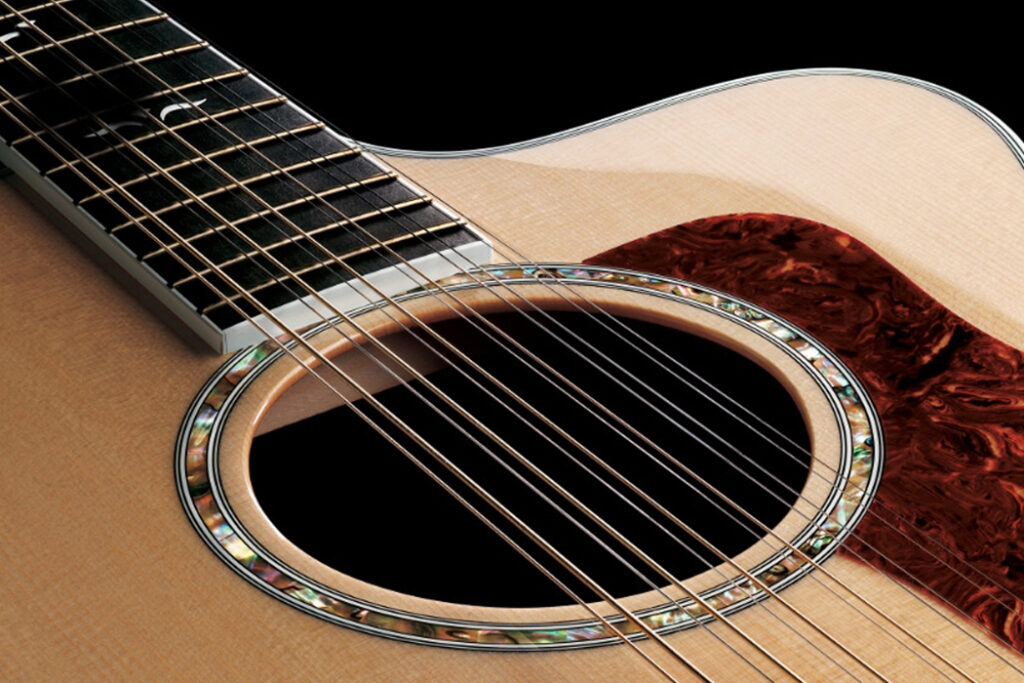Introduction to 12 String Guitar Tuning
12 String Guitar Tuning: You would have felt the magic in its sound if you had ever played a 12-string guitar.
Nevertheless, sometimes, to achieve such beauty of resonance, you have to start with one thing, which is tuning.
The correct tuning of 12-string guitars elevates and clarifies every note. However, for many players, such as beginners, this can be highly frustrating.
Making mistakes while tuning may ruin your sound and lead to unnecessary complications during performing or recording sessions.
In this guide, we will cover common missteps musicians make when tuning their 12 strings and how to avoid them.
Whether you are an experienced guitarist or just starting on your musical path, knowing these errors will ensure that each time you take up your instrument, it sounds as good as it ever has before. Let’s get started.
The Importance of Proper 12 String Guitar Tuning

It is essential to properly tune the twelve strings of a guitar so that you can achieve the full sound that is associated with it. All of the twelve strings participate in a complex harmony that lifts your music high.
A 12-string guitar sounds wonderfully when properly tuned. When chords are played, the octaves offer depth, making them glitter. This richness can transform simple progressions into moving pieces.
On the other hand, wrongly tuned guitars have dissonance or unclear notes. Instead of harmonizing, players may find notes clashing with each other, which might hinder them from expressing their emotions through their musical instruments.
In addition, tuning consistently helps one’s ear as a musician become better at music.
Moreover, being able to distinguish slight differences in the notes will enable a person to adjust their guitar and improve their general musicality and performance abilities.
When clarity really matters during performances or recording sections, proper tuning techniques will always count in any investment made toward mastering such music secrets.
5 Common Mistakes When 12 String Guitar Tuning

Tuning a 12-string guitar can be an enriching experience, but one must know that they are prone to various mistakes.
One of these errors is not using an electronic tuner. Even though experienced players might prefer doing this by ear, electronics give you precision and accuracy in terms of sound.
Yet another mistake is failing to tune the octave strings first. This step ensures that you lay a good foundation for harmony, and it helps avoid complications later.
Over-tightening or under-tightening strings also leads to problems. Strings that are too tight may break, while those that are too loose produce unwanted sloppiness in tone.
Most players forget to check intonation after tuning, which affects playability and overall sound quality. With proper intonation, every note will ring true across the fretboard.
When finger placement on the fretboard is incorrect during tuning, pitch inaccuracies occur. Always make sure your fingers rest properly so you don’t have to make unnecessary adjustments later.
- Not Using an Electronic Tuner
When tuning a guitar, one cannot rely solely on the ears, as this is a dangerous move if you are dealing with 12-string guitars.
Some musicians have excellent pitch, while others do not. An electronic tuner will save you frustration and ensure accuracy.
The use of an electronic tuner makes it much more manageable. In fact, these gadgets can be really good at detecting pitch, which will enable you to tune your strings quickly and easily.
This is essential when working with twelve-stringed instruments, as slight variations may render your music dissonant.
If you don’t have a tuner, you could spend ages trying to improve the intonation without realizing that it has shifted again.
Although this method is excellent for polishing skills, putting technology first helps lay solid grounds for musicianship.
The adoption of an electronic tuner enables you to get the correct sound right from the beginning, thereby making your performance sound professional.
- Neglecting to Tune the Octave Strings First
The octave strings should be the first to tune when setting up a 12-string guitar. It’s these pairs that match each other, resulting in the full and ringing sounds that are characteristic of 12-string guitars.
These bottom strings can affect your overall sound balance if you neglect these higher-pitch strings and tune the lower ones first. The top octaves must resonate harmoniously with their counterparts.
Furthermore, starting with them provides a good base for your guitar. You will be able to hear how the notes work together right from the start.
This makes it easier to spot errors as you go about tuning the remaining strings.
Ignoring this vital step often leads to mistakes. By putting such emphasis on those octave pairs, all notes will be evident through all your playings.
- Over-Tightening or Under-Tightening the Strings

The pressure each string is put under when tuning a 12-string guitar will determine its outcome. Overtightening may lead to broken strings, which will pause your playing and cost you money. Strings should only be tightened to their correct pitch.
Conversely, if the strings are too loose, they produce a dull sound lacking in clearness. Your chords won’t ring out as they should when strings are too loose.
Such an occurrence not only affects your performance but also irritates any listener around you.
One must strike a balance. This ensures that while you tune, it is done delicately so as to avoid the common mistakes stated above. Also, observe how each string changes when you alter its tension.
Employing an electronic tuner could assist in achieving exact pitches without going either way excessively.
Evidently, what we want is constant sound quality amalgamated with being long-lasting on your instrument. Deliberate confusion
- Not Checking for Intonation
A guitar is a musical instrument that must be correctly tuned for it to make sound, especially when it is a twelve-string. There ought to be careful tuning on the frets of this intricate thing.
Despite having tuned their guitar strings already, some people need to remember their intonation.
They can think that having well-tuned open strings will solve everything. Eventually, this will catch them off guard during the performance.
Once your guitar’s intonation is out of tune, you might find yourself playing sharp or flat notes. Harmonizing with others or recording tracks that may not sit well in the mix could, therefore, turn out to be hard and discouraging.
It is crucial to regularly check and adjust intonation so that every note sounds pure at different fret positions.
This process should not be skipped at any cost, especially by those individuals who want their voices to shine out clearly and beautifully.
- Improperly Placing Fingers on the Fretboard While Tuning
The improper placement of fingers on the fingerboard can make tuning a frustrating experience.
It will affect the pitch of the string you are trying to tune when you press too hard or put it in the wrong place. This mistake is common, surprisingly, among novice learners.
It is necessary to ‘lightly touch’ instead of pressing down on strings while doing it so that you do not alter notes accidentally by listening accurately to how each note should sound.
Moreover, when checking different strings, try using only one finger at a time. This helps maintain clarity and prevents confusion between notes.
For instance, tuning entails precision and awareness of finger placement. Observe closely, and you will notice that your guitar stays tuned better with time.
FAQs:
Q: Why is 12 string guitar tuningt?
A: It ensures a rich sound.
Q: How does a tuner help with12 string guitar tuning?
A: It ensures accurate tuning.
Q: What are common12 string guitar tuning mistakes?
A: Skipping octaves and wrong tension.
Q: Why tune octaves first in 12 string guitar tuning?
A: It sets a solid base.
Q: How does tension affect 12 string guitar tuning?
A: Proper tension prevents breakage.
Q: What is intonation in 12 string guitar tuning?
A: It keeps notes in tune.
Q: Can finger placement impact12 string guitar tuning?
A: Yes, it can cause errors.
Q: How often to check intonation in 12 string guitar tuning?
A: Regularly.
Q: What role does a tuner play in 12 string guitar tuning?
A: It ensures precision.
Q: How do you improve beginner 12-string guitar tuning?
A: Use a tuner, tune octaves, and adjust tension.
CONCLUSION:
Rewarding tuning a 12-string guitar goes far in supplying vibrant sounds and dimension to your music. However, there’s more that you should do to enjoy the best sound ever.
Use an electronic tuner; emphasize octave strings; adjust tension accurately; check intonation; place fingers rightly on the fretboard all through tuning. That’s how you can go about this.
A well-tuned 12-string guitar allows for creativity. Follow these tips to improve your playing and listening skills significantly.
You can learn it through practice and attention to detail and discover that mastering the nuances of 12-string guitar tuning opens up new musical possibilities for you. Keep playing!

